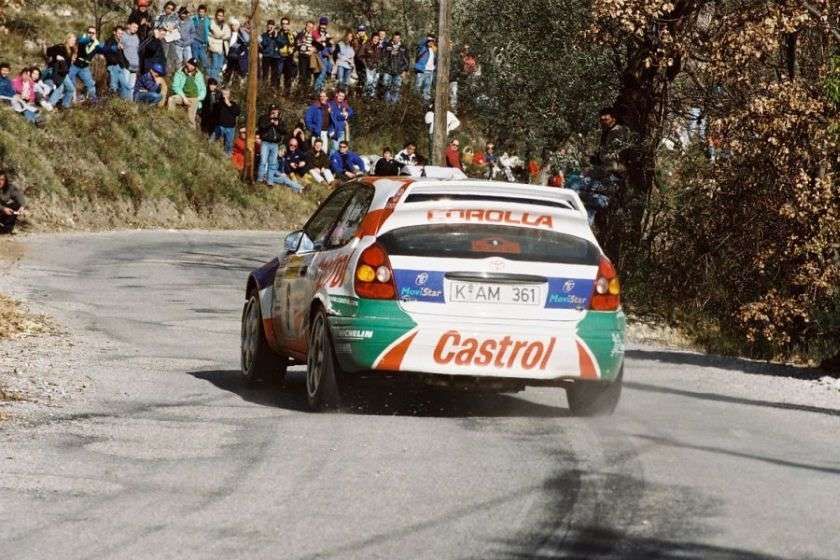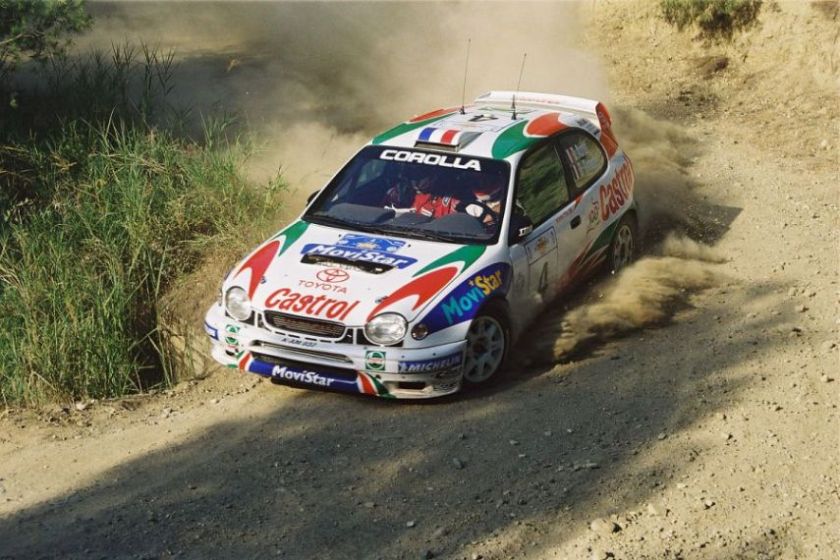Toyota Corolla WRC - Pride and Sorrow in the Same Car
Toyota Corolla WRC is a race car which Japanese marque was using between 1997 and 1999 as an official manufacturers’ entry in the World Rally Championship, although a car was in use for few more years with non-factory teams. The biggest success was the 1999 World Rally Championship title for Toyota Castrol Team, with Carlos Sainz and Didier Auriol as leading drivers. Corolla WRC scored four WRC wins and thirty WRC podiums in its lifetime.

Toyota Corolla WRC
Corolla WRC came after a one-year ban for Toyota
Corolla WRC is based on the eighth generation (E110) of world’s most popular compact car, introduced in 1995. It was the year of controversial World Rally Championship season when Toyota Castrol Team was caught using illegal turbo restrictors on its Celica GT-Four cars during the Rally Catalunya. The team was given a one-year ban by the FIA.
Toyota was back in 1997, the first year when WRC-spec car started to replace Group A cars. Subaru and Ford were first to introduce Impreza WRC and Escort WRC, followed by Toyota in the second part of the season.

Didier Auriol scored two WRC wins with Corolla
The first generation of WRC cars
The first generation of WRC cars featured 2.0-litre four-cylinder turbo engines, sequential gearboxes and four-wheel-drive, with a power output of 300 hp (official number), although it was believed that some WRC engines produced about 330-340hp.
Toyota Corolla WRC was using a modified 4WD system from Celica GT-Four ST205 and 3S-GTE engine which was also used in the previous rally car.
Debut for Corolla WRC at 1997 Rally Finland
In the first part of the season, Toyota was using Celica GT-Four cars, bringing the Corolla WRC for the first time at 1997 Rally Finland, the tenth round of the championship. Didier Auriol finished seventh, Marcus Gronholm retired.
In the next event, Rally Indonesia, both Auriol and his Australian teammate Neil Bates retired. At 1997 Rallye Sanremo, Freddy Loix scored fifth place with #10 Corolla, Auriol was in the 8th place. The first ever podium for Toyota Corolla WRC followed at Rally Australia in November 1997, with Didier Auriol finishing third.

Carlos Sainz at 1998 Rallye Monte-Carlo
Maiden victory at 1998 Rallye Monte-Carlo
In 1998, Carlos Sainz left Ford to join Toyota Castrol Team. His #5 Corolla WRC was a victorious car in the season-opening Rallye Monte-Carlo. Two more wins followed during 1998, Sainz at Rally New Zealand and Auriol at Rally Catalunya.
With two wins and five more podiums, Carlos Sainz came to the last round of the championship as the second-placed driver in the overall standings, two points behind Tommi Makinen.
Video : 1998 WRC season’s dramatic finale
Corolla stopped, Sainz lost championship title
And then the probably biggest ever drama in WRC history happened, at Network Q Rally Great Britain. The championship leader Makinen retired early, after an accident on the Special Stage 7.
Sainz was running comfortably fourth on the last special stage, which was a result for his third championship title until his Corolla stalled out about 300 meters from the finish line in Margam Park. Sainz was desperate, he even broke the window in the car, but Makinen became a champion instead, for the third time in his career.

Carlos Sainz at 1999 Rallye Sanremo
1999 – one win, fifteen podiums and world’s title for Toyota
In 1999, Makinen was a champion again, for the fourth time in a row. Carlos Sainz and Didier Auriol were the front-runners again, scoring fifteen podiums in fourteen races, including three double-podium results and Auriol’s victory at China Rally.
Auriol finished third in the championship points, Sainz was fifth. Together, they secured Manufacturers’ title for Toyota, the third title for Japanese manufacturer after two previous triumphs in 1993 and 1994.

Toyota Corolla WRC, championship winning car in 1999
Toyota factory team withdrew from WRC in 2000
With the championship title on its table, Toyota decided to withdraw its factory team from WRC to concentrate on the Formula One program. Private teams continued to run Corolla WRC cars for few more years, scoring no more wins but achieving some notable results. The best result was a third place for Harri Rovanpera at 2000 Rally Finland. Rovanpera also finished fourth at 2000 Rally Portugal, same as Thomas Radstrom at 2000 Rally Sweden. At 2000 Rallye Monte-Carlo, Bruno Thiry finished fifth with Corolla. It’s interesting that one of the privateers who drove Corolla was Sebastien Loeb, who finished ninth at 2000 Tour de Corse.
After 2002 season, Toyota Corolla WRC disappeared from the World Rally Championship, but it is still a popular car in many national championships and non-championship events for historic rally cars. In 2017, Toyota is returning to WRC with its factory team, introducing a 380-hp Yaris WRC.

Toyota Corolla WRC with its successor Yaris WRC
Photos: ewrc.cz, toyota-motorsport.com, tech-racingcars.wikidot.com,







